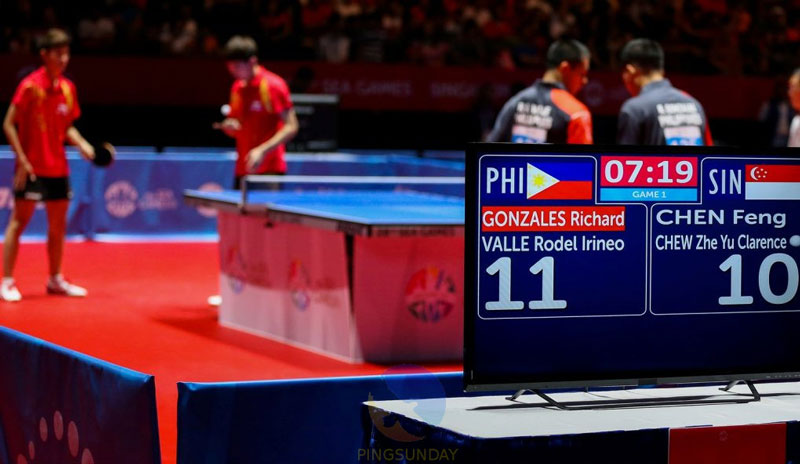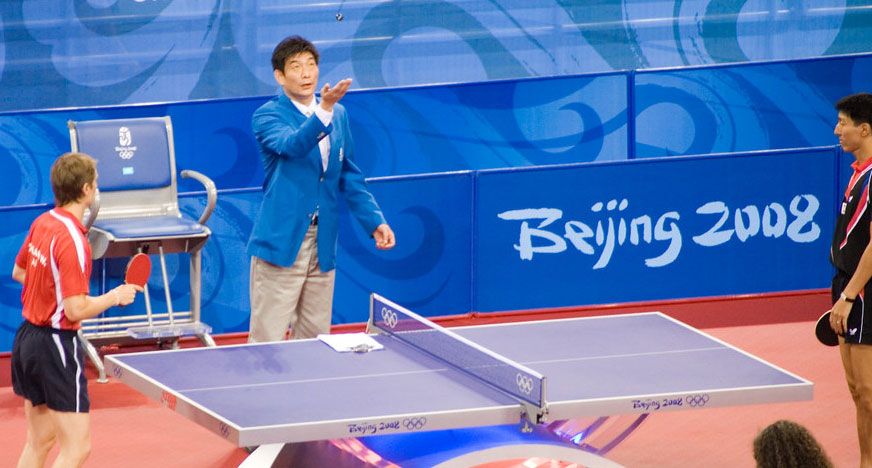Are there different rules for Amateurs and Professionals?
The basic rules of table tennis, or to give them their correct title – The Laws of Table Tennis – are the same for both amateurs and professionals, BUT for higher levels of play there are many additional Regulations which supplement these basic rules.
How many of these additional Regulations are actually used will depend upon the standard of the competition being played, and whether the organisers have adopted all or any of them.
But for now, let’s just take a look at a few of the basic rules of table tennis which you’ll need to know in order to play a game with your friends.
OK, let’s look at the most basic rule of table tennis…
Is a game up to 11 points or 21 points?

Up until 2001 a table tennis game was played up to 21 points. But in order to make the game more exciting, have more “crucial” points, and to make it more appealing to television viewers, the rules of table tennis were changed.
A game of table tennis is now played up to 11 points.
The winner is the player or pair who first scores 11 points, unless both players or pairs score 10 points (called deuce). Then a game will be won by the first player or pair to gain a two point lead.
Start a game

Before you start a game, you’ll need to decide who’s going to serve first.
If you’re just playing a game with friends, you can use whatever method you like to decide this, but the official rules of table tennis say that it’s decided by lot, usually by tossing a coin or disc having two distinct sides.
However, a common method used at lower levels of play is for one player (or the umpire) to hide the ball in one hand, then put both hands under the table or behind their back, and then ask the opponent to guess which hand the ball is in.
Although the winner of this often serves first, he does actually have three choices…
The winner can:
- elect to serve first or
- make his opponent serve first or
- decide which end of the table he prefers to play at first
If the winner chooses a particular end of the table, his opponent then has the choice of whether to serve first or to make his opponent serve first.
If the winner chooses to serve first, his opponent then has the choice of which end of the table he prefers to play at first.

Basic table tennis serve
The rules of table tennis have been changed many times in recent years in relation to the service law, but for a casual game of table tennis it remains very simple.
The ball must be above the level of the playing surface and behind the server’s end line (or an imaginary extension of it). This essentially means that the server must stand behind the end of the table to serve.
The basic serve involves holding the ball in the palm of your non-playing hand and throwing it upwards.
As the ball is falling, you must hit it with your racket (also known as a paddle or bat) held in your playing hand so that it bounces once on your side of the table, and at least once on your opponent’s side of the table.
If your opponent allows the ball to bounce more than once on their side of the table, they will lose the point.
The ball may bounce anywhere on both sides of the table and, unlike tennis, you don’t have to serve to one part of the table – unless you’re playing doubles.
If the ball touches the net and still bounces on your opponent’s side of the table, the service must be replayed.
However, if the ball touches the net and does not bounce on your opponent’s side of the table, the server loses the point.
The ball is “in play” from the moment that the server deliberately throws the ball up.
How many serves?
Prior to 2001 when table tennis was played up to 21 points, the rules were essentially the same, but each player had five consecutive serves and deuce was at 20-20. At deuce, service alternated until one player or pair gained a two point lead.
But after the rule change in 2001, the number of serves that each player had was also changed.
Now, each player has two serves each and service continues to alternate between opponents until one player scores 11 points, unless both players or pairs score 10 points (called deuce).
If both players reach 10 points, then service alternates after each point, until one player gains a two point lead

Returning the serve
Your opponent must hit the ball back over the net so that it bounces only on the server’s side of the table and the ball must bounce at least once on the server’s side of the table.
If you allow the ball to bounce more than once on your side of the table at any time, you lose the point.
When returning the serve, or during a rally, if the ball hits the net but does not hit your opponent’s half of the table, then a point is awarded to your opponent.
However, if the ball hits the net but still goes over and bounces on your opponent’s half of the table, the rally continues.
The receiver can stand wherever they want and can play their returns from any position. However, players are not allowed to touch the table with their free hand (the hand not holding the racket) and they are not allowed to move the table.
If the server imparts backspin on the ball which causes it to go back over the net towards the server after bouncing on the receiver’s side, the receiver must still hit the ball before it bounces on the server’s side of the table. This means that the receiver will need to go beyond the net to play a stroke. If the receiver does not hit the ball before it bounces back on the server’s side of the table, the receiver loses the point.
During a rally
Whilst a rally is taking place, and a point is in the process of being decided, both players can stand wherever they want and can play their shots from any position, including beyond the net on their opponent’s side of the net.
Therefore, if a player imparts backspin on the ball which causes it to go back over the net towards them, the receiver must still hit the ball before it bounces on the other side of the table. This means that the receiver will need to go beyond the net to play a stroke. If the receiver does not hit the ball before it bounces back on the server’s side of the table, the receiver loses the point.
Doubles

When playing doubles, each player still has two serves and the service still alternates every two points between teams, but it also alternates between players on the same team.
At the end of every two points, the receiving player becomes the server, and the partner of the serving player becomes the receiver.
The service itself is exactly the same as in singles except that, rather than the ball bouncing anywhere on the table, it must bounce only on the right half portion of the table for both the server and the receiver.
The receiver returns it, then the server’s partner must hit it next followed by the receiver’s partner and so on.
Play must continue in this sequence throughout the rally and if a player hits it out of turn he loses the point.
Score a point
To score a point, you must keep the ball in play longer than your opponent.
A player loses a point if he:
- Fails to make a good serve (eg. throwing the ball in the air and failing to hit the ball or failing to hit it onto his opponent’s side of the table)
- Allows the ball to bounce twice on his side of the table
- Does not hit the ball after it has bounced on his side of the table
- Does not hit the ball onto his opponent’s side of the table
- Hits the ball before it has bounced (i.e. volleying the ball) unless it’s obviously not going to bounce on his side of the table
- Hits the ball twice in succession (i.e. a double hit)
- Puts his non-playing hand on the table or net or moves the table
- Obstructs the ball with any part of his body or clothing (unless it’s obviously not going to bounce on his side of the table)
- Hits the ball out of turn when playing doubles

A Game
As we saw earlier, when one player has scored 11 points (or when one player has a two point lead if the score previously reached 10-10), he wins the game.
However, there is a time limit on how long a game can last. This is known as the Expedite rule and comes into operation after 10 minutes of play – unless 18 points have already been scored.
If at least 18 points have already been scored, the game continues to a conclusion – however long it takes.
The players then swop ends and the next game begins with the player who served second in the previous game.
A Match
The rules of table tennis state that a match is the best of any odd number of games – usually 3, 5 or 7 games.
